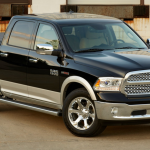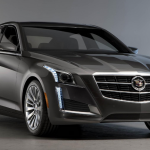
I didn’t see it coming, it just happened. I stepped out of one $70,000 car, and stepped directly into another.
As an auto writer, that coincidence alone does not qualify as amazing. Also not surprising is that fact that these two cars are vying for the same shoppers, more or less.
No, what’s worth noting is that one of these cars is a Cadillac, and the other a Hyundai.
Test Drive: 2018 Cadillac XTS V-Sport
To put some perspective on how far these brands have traveled to reach this strange and wonderful point in history, think back 25 years.
A quarter century ago the largest Cadillac sedan was the barge-like Brougham, a lumbering land yacht powered by a carbureted 170-horsepower 5.0-liter V8. At 221 inches long, the Brougham stretched a solid five feet beyond the rear bumper of Hyundai’s largest (and only) contemporary sedan, the Excel. The Brougham started at $25,699.
And, what of Hyundai? Still very much an economy brand, Hyundai was better known for innovative rebates (trade in any car for a guaranteed $1500) than for building anything worth driving. Powered by a 68-horsepower 1.5-liter engine, the maker’s compact Excel could lay claim to being thrifty with fuel, and pretty much nothing else. Excel prices started at $5499.
Books could be written about what happened to these two brands in the past two and a half decades, but suffice it to say, things got better for both of them. Cadillac’s largest sedan is now better suited for the Autobahn than trolling between Miami bingo halls, and Hyundai’s most impressive four-door is now a viable option for folks looking for an alternative to flagship German luxury sedans, not first-time shoppers trying desperately to get financed.
But seriously, $70,000? Yes, seriously. Keep in mind, these loaded-up examples represent everything these models have to offer. In both cases, decently equipped lesser versions can be had for fully $20,000 less.
And how do they stack up against each other? Let’s have a look:
Steve and Johnnie Road Test: 2018 Genesis G80 3.8
Cadillac versus Genesis
2014 Cadillac XTS Vsport 2014 Hyundai Equus Ultimate
Price: $71,015 $68,920
Engine: 3.6-liter twin-turbo V6 5.0-liter V8
Horsepower 410 429
Drive: All-wheel Drive Rear-wheel Drive
Wheelbase 112-inches 120-inches
Length 202 inches 203 inches
Curb weight 4437 lbs. 4555 lbs.
EPA fuel econ. 16/24 city/highway 15/23 city/highway
Power Tie
Instrumented testing by enthusiast magazines has both of these muscle-bound sedans reaching 60 mph from a stop in just over five seconds. Credit the Equus for its immediate power delivery, delivering old-school big-block style torque just off idle.
Handling Equus
Folks familiar with the Cadillac DeVille DTS need only imaging that car on steroids to understand how the XTS feels when the road gets twisty. The big Caddy enjoys ample grip, but leans significantly in corners and on off ramps. On the plus side, the steering is tighter and better connected-feeling than any DeVille’s ever was, and the brakes do a nice job hauling this big rig down. The Equus, on the other hand, handles more like the big German sedans it’s meant to feel like. The big Hyundai is much easier to control when the road starts to bend, and there’s little lean in anything less than very aggressive driving. Note: The XTS Vsport comes standard with AWD—always handy in snowy climes.
Ride XTS
This one isn’t even close. Hyundai has struggled trying to strike the perfect ride and handling balance on its big rear-drive sedans, and though much improved for 2014, the Equus is no match for the ultra-refined XTS. Road imperfections that result in a startling crash in the Equus register with just a muted thud in the XTS. At speed, the Cadillac rivals Germany’s best for ride comfort.
Cabin Appointments XTS
The Equus is very nice inside, but the XTS is ridiculous—in the best possible way. Cadillac’s new design credo seems to be to take cabin appointments 10 percent over the top, and apologize to no one for the lavishness. Some shoppers may find the XTS interior overdone, but it’s hard to argue with the obvious top-notch quality of the materials and artisan-like workmanship. The Equus cabin is by no means stark, but seems to pay homage to the restrained sterility of recent-generation big BMWs rather than the clubby wood and leather look now popular. The Equus is nice, the Cadillac fabulous.
Styling Equus
I’ll just fess up now, I think the XTS looks wonky. Unlike the lean, purposeful 2014 CTS now hitting the road, the XTS looks to me as if the headlights are on the wrong end of the car. Hyundai is still playing it safe with the Equus, going with fairly anonymous lines and committing to personality only up front, where the big grille stands laden with shiny bits.
Overall XTS
All told, despite their similar size, power ratings, and pricing, the Cadillac XTS Vsport and the Equus Ultimate are very different animals. The Cadillac, it seems, is trying to be the best-ever DeVille, while the Equus wants to be what the BMW 7-Series was before it became a lightning-fast rolling electronics store.
In both cases, job well done. For me, I’ll take the Equus. But, that’s just for me. I appreciate the understated simplicity of the Equus, especially its simple, robust, old-school big V8.
That said, the Cadillac seems to offer more for the money. It rides better, looks nicer inside, and should return better real-world fuel economy. However, shoppers looking for real-luxury with a dose of anonymity wont go wrong with the Equus.
Both cars, it should be noted, offering power and performance unthinkable from either make just a generation ago—all for $30,000-to-$40,000 less than the price of a BMW 7-Series.
Test Drive: 2018 Genesis G80 Sport



